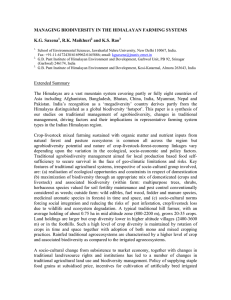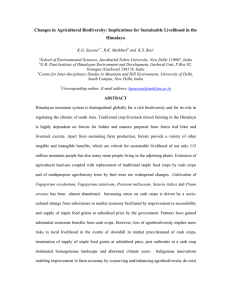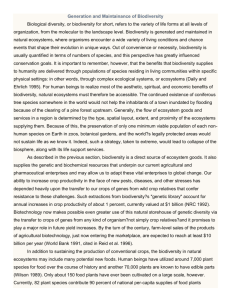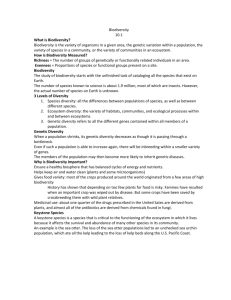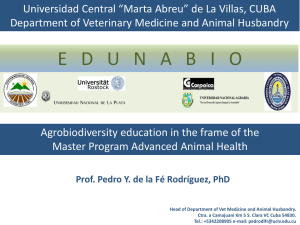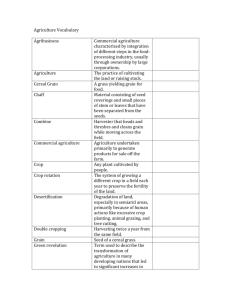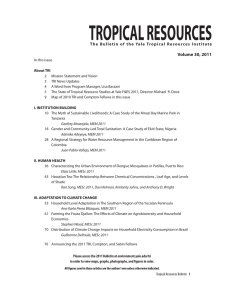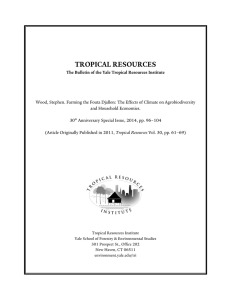Managing biodiversity in the Himalayan farming systems
advertisement
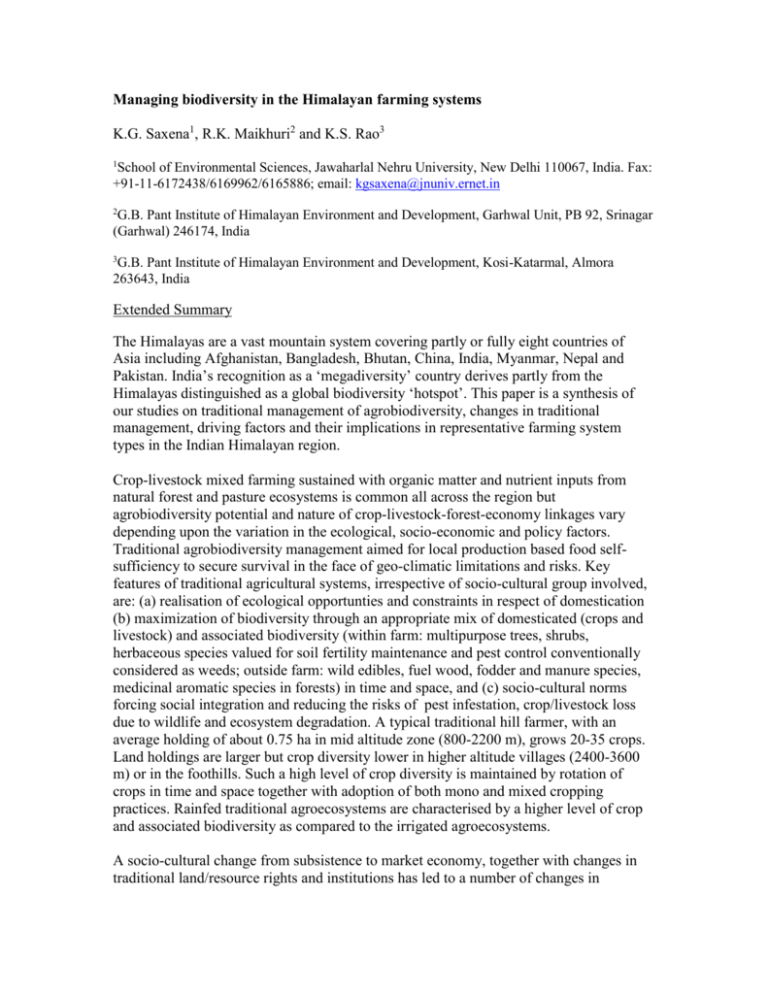
Managing biodiversity in the Himalayan farming systems K.G. Saxena1, R.K. Maikhuri2 and K.S. Rao3 1 School of Environmental Sciences, Jawaharlal Nehru University, New Delhi 110067, India. Fax: +91-11-6172438/6169962/6165886; email: kgsaxena@jnuniv.ernet.in 2 G.B. Pant Institute of Himalayan Environment and Development, Garhwal Unit, PB 92, Srinagar (Garhwal) 246174, India 3 G.B. Pant Institute of Himalayan Environment and Development, Kosi-Katarmal, Almora 263643, India Extended Summary The Himalayas are a vast mountain system covering partly or fully eight countries of Asia including Afghanistan, Bangladesh, Bhutan, China, India, Myanmar, Nepal and Pakistan. India’s recognition as a ‘megadiversity’ country derives partly from the Himalayas distinguished as a global biodiversity ‘hotspot’. This paper is a synthesis of our studies on traditional management of agrobiodiversity, changes in traditional management, driving factors and their implications in representative farming system types in the Indian Himalayan region. Crop-livestock mixed farming sustained with organic matter and nutrient inputs from natural forest and pasture ecosystems is common all across the region but agrobiodiversity potential and nature of crop-livestock-forest-economy linkages vary depending upon the variation in the ecological, socio-economic and policy factors. Traditional agrobiodiversity management aimed for local production based food selfsufficiency to secure survival in the face of geo-climatic limitations and risks. Key features of traditional agricultural systems, irrespective of socio-cultural group involved, are: (a) realisation of ecological opportunties and constraints in respect of domestication (b) maximization of biodiversity through an appropriate mix of domesticated (crops and livestock) and associated biodiversity (within farm: multipurpose trees, shrubs, herbaceous species valued for soil fertility maintenance and pest control conventionally considered as weeds; outside farm: wild edibles, fuel wood, fodder and manure species, medicinal aromatic species in forests) in time and space, and (c) socio-cultural norms forcing social integration and reducing the risks of pest infestation, crop/livestock loss due to wildlife and ecosystem degradation. A typical traditional hill farmer, with an average holding of about 0.75 ha in mid altitude zone (800-2200 m), grows 20-35 crops. Land holdings are larger but crop diversity lower in higher altitude villages (2400-3600 m) or in the foothills. Such a high level of crop diversity is maintained by rotation of crops in time and space together with adoption of both mono and mixed cropping practices. Rainfed traditional agroecosystems are characterised by a higher level of crop and associated biodiversity as compared to the irrigated agroecosystems. A socio-cultural change from subsistence to market economy, together with changes in traditional land/resource rights and institutions has led to a number of changes in traditional agricultural land use and biodiversity management. Policy of supplying staple food grains at subsidised price, incentives for cultivation of artificially bred irrigated cultivars of paddy and wheat or cash crops like potato and temperate fruits, and lack of any support for marketing of indigenous rainfed crops resulted in complete abandonment of or drastic reduction in area under Fagopyrum esculentum, Fagopyrum tataricum, Flemingia vestitata, Hordeum himalyens, Panicum miliaceum, Parilla frutesence, Macrotyloma uniflorum, Pisum arvense, Vigna umbellata and several local cultivars of rainfed paddy and wheat. This means a significant loss of agrobiodiversity whose nutritional, economic and ecological potentials remain ‘unknown’ or ‘lesser known’ to the scientific and wider communities. There are isolated examples of indigenous innovations of cultivation of new crops in response to restrictions on access to wild resources as a result of conservation policies. Bhotiya farmers have started cultivating eight medicinal species viz., Allium humile, Allium stracheyi, Angelica glauca, Carum carvi, Dactlorhiza hatagirea, Megacarpaea polyandra, Pleurospermum angelicoides and Saussurea costus in the last 20 years in response to termination of their traditional rights of utilization of these species in the Nanda Devi Biosphere Reserve. A larger farming community in central Himalaya has started cultivating Cleome viscosa, a medicinal and spice plant, which used to be harvested from the wild. Nevertheless, erosion of traditional agrobiodiversity is more extensive than the indigenous efforts towards cultivation of new crops. Changes in crop diversity are such that economic losses due to diseases and wildlife have increased, fodder production from farm lands has declined while rates of organic manure (derived from livestock excreta and forest leaf litter) input has substantially increased. These trends imply increasing pressure on forests for fodder and manure. As soil erosion under the changed cropping patterns is quite high, instances of land abandonment and cultivation of new patches in forests are becoming more common. Abandoned agricultural land surves as refuge for biological invaders particularly Eupatorium odoratum, Lantana camera and Ageratum conyzoides. Enforced land tenure regimes and institutional arrangements discourage traditional ways of biodiversity and ecosystem management on a landscape scale. Agricultural biodiversity has been a neglected dimension of conservation policies and programmes, even though it is an essential component of biosphere reserve management plans introduced in late1980s. Traditional agricultural systems have been considered more as a threat to wild biodiversity and ecosystem functions than as a potential foundation of developing ecologically sound food production systems. Many traditional crops are highly profitable but farmers adapted to subsistence economy are unable to realise potential profits from marketing. Options for conservation of biodiversity together with improvement in local economy and Himalayan ecosystem services arising out of our studies include: (a) enhancement of local knowledge of the economic potential of traditional agrobiodiversity (b) suppression of exploitation of hill farmers by middlemen in the market (c) incentives for cultivation of traditional crops with comparative advantages (d) improvement in traditional soil fertility management practices enabling a better synchrony between nutrient release and crop uptake by manipulating the quality of manure and rotation of crops in space and time (d) rejuvenation/strengthening of traditional socio-cultural norms enforcing integrated landscape management.
